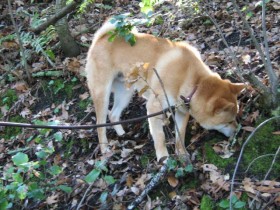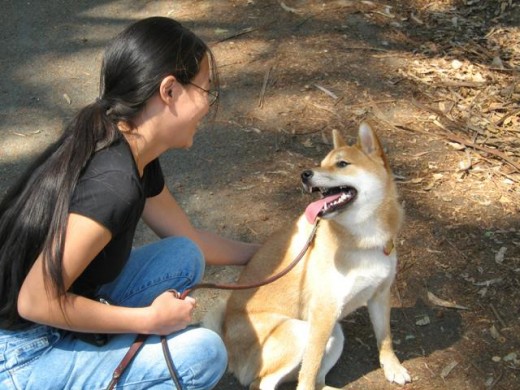Why Do Dogs Pull?
Dogs pull for a variety of reasons.
- Dogs naturally walk at a faster pace than we do.
- Dogs, especially young dogs are happy and excited to be outdoors. This makes them want to get to as many places as possible, in as little time as possible.
- Dogs pull to get to people or other dogs that they see walking on the road. Usually they just want to examine the new people or dogs, and smell them.
- Dogs pull when they see prey because instinctually, they want to chase and catch it.
- Dogs pull when they are afraid of something and want to run away.
Contrary to what some people say, dogs do not pull because of dominance or to show their owner “who is boss”.
Then why did the dog pull while crossing the road?
Because he wanted to get to the other side … quickly.
Dominance, power, and control are very human motives that we often incorrectly overlay onto normal and instinctual canine actions.

How to Stop Your Dog from Pulling

First, we consider how to get our dogs to reduce their natural walking speed so that their much slower two-legged companions can keep up.
One of the most effective ways to get a dog to slow down is to teach him the following –
The fastest way to get to where he wants to go is by slowing down and walking with you.
As soon as your dog starts to pull, i.e., the leash gets taut, non-mark (Ack, Ack) and just stop walking. Initially, your dog may continue to pull and may even pull harder. Just ignore him and stand still.
As soon as your dog stops pulling, you can start moving forward. In this way, your dog learns that pulling = we stop moving, and not-pulling = we get to where we want to go.
For this method to work, it is important to be consistent with your starts and stops. Do not let your dog pull sometimes, but not at other times. Make sure to stop every time the leash gets taut and start again once your dog has stopped pulling.
In the beginning you may find yourself stopping a lot and may not get very far from your front door. But that is fine and part of the learning process. Keep going at it consistently, and your dog will quickly learn that it is in his best interest to slow down and walk together with you.

1. Prey Drive
Most dogs have a difficult time resisting squirrels and other prey. Once a dog spots a squirrel, the only thing in his mind will be to chase after that bushy tail. He will no longer be interested in food, in toys, or in what you have to say.
This has nothing to do with dominance or being the boss. It is simply in a dog’s DNA to hunt, since they come from a line of predators. Some dog breeds have higher prey drive than others, and some dog breeds are more independent than others. The independent dog with high prey drive are the most susceptible to the Squirrel Effect.
Such dogs will be difficult to control when exposed to a squirrel, especially a moving squirrel. And it is not just squirrels but also cats, deer, and other prey.
Some people suggest that the only way to deal with pulling in such situations is to use aversive training, including finger pokes, leash jerks, or shock collars. Pain is often a strong motivator, therefore it can sometimes be used to snap a dog out of his squirrel trance.
However, if our dog is independent and has strong prey drive, the pain that we must deliver must be even stronger. As a result such techniques are risky, may cause your dog to lose trust in you, may cause aggression, will increase the amount of stress experienced by your dog, and will reduce his quality of life.

2. Desensitization

An effective and safer way to deal with prey drive is through desensitization exercises.
Desensitization exercises work by first exposing your dog to only a small amount of the problematic stimulus. For example, we start by standing far away from the Squirrel Zone. We must stand far enough away that our dog is still calm, able to focus on us, and able to perform obedience commands.
Then we do the following –
- Get our dog’s attention and reward him for giving us his attention.
- Get our dog to do some simple obedience commands and reward as appropriate.
- Move one or two steps towards the Squirrel Zone.
- Repeat the steps above.
If our dog fixates on the squirrel and starts to pull, then we have moved forward too quickly. We want to move back a few steps and repeat the exercise. Make sure to keep desensitization sessions short, fun, and rewarding. Do not overload the dog with too much at any one time.
The desensitization process helps to retrain our dog to ignore the squirrel and focus on us instead.
The desensitization process is best performed in a controlled environment, for example in our backyard or a quiet neighborhood field. Pick an area where there are few distractions so that we can focus all of our training on a single problematic stimulus.

3. Pain and Fear

Even though we used squirrels in the example above, the desensitization process can be used to help with a variety of pulling issues including pulling to meet people and other dogs. Desensitization can also help with fear pulling.
My Siberian Husky used to be very fearful of the garbage truck. During our walks, she would start pulling like crazy whenever she saw or heard the garbage truck. To help her with this issue, I started doing focus and obedience exercises inside the house, but close to the front door during trash days. Then we did exercises on-leash but with the front door open, then we did exercises on the front step and so on. Now, we only need to move into a driveway and she remains calm enough to focus and do commands.
Remember, however, that fear and prey drive are powerful things.
While it is possible to desensitize your dog to a certain level, it may not be possible to ensure perfect success. Instead, the prey drive will still be present – but be muted – because your dog has learned that focusing on you in the presence of a squirrel or cat is a very rewarding enterprise.
Incidentally, applying pain through a leash jerk, finger poke, or shock collar does not magically remove a dog’s prey drive either. In that case, the prey drive is just suppressed by another stronger instinct – pain avoidance or fear of pain.

I have a ten month golden lab. I have been practising stopping every time he pulls…I changed from collar to harness…when he does walk nicely beside me even for a few strides I quickly reward with a treat and say good dog….
I have been doing this for two and a half months …he doesn’t get it…he knows when he’s good and walks beside me nice,y but 95 percent of the time he pulls..I am exhausted walking him…what am I doing wrong ?. He’s just not getting it…
Hi Lori,
I had the same problem with my 3 month old husky puppy. I switched from harness to prong collar. I’ve been giving my puppy obedience training too. She’s very good with sit command. When I made her walk with prong collar, every time she pulled, I stopped and the prong collar tightened. and she would sit. Time to move again and she pulled, same repetition of behavior from my end. She learned it quickly that if she pulls, she’s not getting her walk and her collar tightens. The reward is a good walk at my pace with free collar and no stops. My canine trainer said, don’t use harness especially if your dog pulls.
Give this a try and I hope it works out for you too.
Good luck!
Thank you for this article. My 16 month old lab went into a burst of energy outside and literally knocked me down and broke my ankle. I wish I had read this sooner!
my border collie doe fear pulling he has a fear of anything that blows in the wind light large flags on poles on other signage he see he is telling me with his body language and pulling that he is saying no i don’t like it i would like him to get over this fear but it is going to be an uphill battle.
I Have tried the stop start method with my border collie on walks i will stop he will pull then stop and the leash goes slack then we go i have been doing this for weeks not everyday but when the weather is good but he still is pulling and when he sees new people he will want to smell them this make take some while before he picks it up.
Nothing works on my dog I’m seriously considering giving up I’ve tried everything. She just starts barking and lunging without stopping. I’ve tried head collars, stopping, going home, practice in the garden, treats, punishment….everything it doesn’t work. My dog is untrainable. This has been going on for 2 years now.
What breed is your dog? Some breeds are more trainable than others. Try talking to a trainer or vet.
I’ve pretty much come to the conclusion that there just isn’t much you can do about a dog’s desire to pull, especially with some breeds… the instincts are just too strong. You can’t exactly train them out of it. Just get a nice sturdy leash and try to keep it under control.
Hi, I just came across this site and I could use some help. I have a 1 year old Am Staff mix who weighs approximately 80 pounds, which is a lot of strength for me to handle, much less my 68 year old mother who he jerked off her feet. I’m trying to work with him on the stopping and walking slow and for the most part, he does well, but when he gets overexcited, well, you can just about imagine. Yesterday he actually caused my mom to hit the ground and I’m trying to avoid her going to the hospital with a hip injury. Any advice on other methods or equipment we could use to keep her safe?
Hello I’m having a napeolian mastiff 7 mth old. He pulls a lot& does not listen to any command.